Table 1.
Summary of potential inhibitors for MTB and non-MTB isocitrate lyase (ICL).
| Number | Published year | Inhibitor | Source | Description | Target ICL | Inhibition* (IC50) | Remarks |
|---|---|---|---|---|---|---|---|
| 1 | 1977 | Itaconate [11, 14] 
|
Synthetic | Succinate analog | Pseudomonas indigofera | K i = 120 | Established inhibitor |
|
| |||||||
| 2 | 1982 | 3-Nitropropionate [11, 15] 
|
Synthetic | Succinate analog | Pseudomonas indigofera | K i = 120 | Established inhibitor |
|
| |||||||
| 3 | 1990 | Mycenon [60] 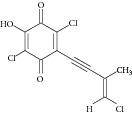
|
Mycena sp. | Fungi |
Acinetobacter calcoaceticus
Neurospora crassa Ricinus communis |
5.2 μM 7.4 μM |
No information on positive control |
|
| |||||||
| 4 | 1990 | 3-Bromopyruvate [11, 16] 
|
Synthetic | Glyoxylate analog | Escherichia coli | 3 μM | Established inhibitor |
|
| |||||||
| 5 | 2005 | DNAzyme [41] | Synthetic | — | Mycobacterium tuberculosis | — | |
|
| |||||||
| 6 | 2006 | Extract of traditional Chinese medicine [30] |
Zingiber officinale,
Illicium verum |
Plant | Mycobacterium tuberculosis | 47.7 μg/mL 18.2 μg/mL |
Positive control IC50 of itaconate = 90 μg/mL (good inhibitory) |
|
| |||||||
| 7 | 2007 | Hydroquinone derivatives [62] 
|
Synthetic | — | Candida albicans | 0.28–1.02 mM | Positive control IC50 of itaconate = 0.06 mM (weak inhibitory) |
|
| |||||||
| 8 | 2007 | Halisulfate 1 [46, 47] 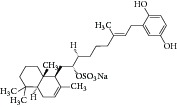
|
Hippospongia sp. | Marine sponge | Magnaporthe grisea | 12.6 μM | No information on positive control (high inhibitory) |
|
| |||||||
| 9 | 2007 | Bromophenols [27] 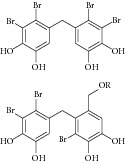
|
Odonthalia corymbifera | Red algae | Magnaporthe grisea | 2.0–2.8 μM | Positive control IC50 of 3-nitropropionate = 94.2 μM (high inhibitory) |
|
| |||||||
| 10 | 2008 | Polyoxygenated diterpenes [61]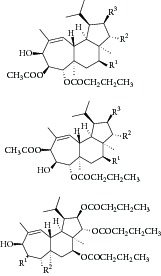
|
Phorbas sp. | Marine sponge | — | LC50 of 55–140 μg/mL |
No information on positive control (weak inhibitory) |
|
| |||||||
| 11 | 2008 | Meroditerpenoids [48]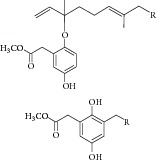
|
Sargassum siliquastrum | Brown algae | Candida albicans | 50–95 μg/mL | No information on positive control (weak inhibitory) |
|
| |||||||
| 12 | 2008 | Dihydroxystyrene metabolites [49]
|
Association of Poecillastra wondoensis and Jaspis sp. | Marine sponge | Candida albicans | 28.7 to >200 μg/mL | Positive control IC50 of itaconate = 5.8 μg/mL (weak to moderate inhibitory) |
|
| |||||||
| 13 | 2008 | Sesterterpenoids [50]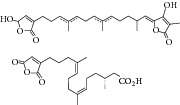
|
Sarcotragus sp. | Marine sponge | Candida albicans | 12.5–19.9 μg/mL | Positive control IC50 of Itaconate = 4.9 μg/mL (moderate to high inhibitory) |
|
| |||||||
| 14 | 2008 | Sesterterpene sulfates [51]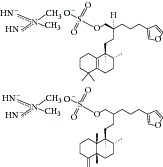
|
Dysidea sp. | Marine sponge | Candida albicans | 31.3–33.8 μM | Positive control IC50 of 3-nitropropionate = 50.7 μM (high inhibitory) |
|
| |||||||
| 15 | 2009 | Pthalazinyl derivatives [35]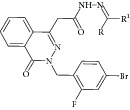
|
Synthetic | — | Mycobacterium tuberculosis | 45–61% inhibition at 10 μM |
Positive control 3-nitropropionate has 63.2% inhibition at 100 μM |
|
| |||||||
| 16 | 2009 | Hyrtiosin B [52]
|
Hyrtios sp. | Marine sponge | Candida albicans | 89 μM | Positive control IC50 of 3-nitropropionate = 50.7 μM (high inhibitory) |
|
| |||||||
| 17 | 2010 | Phthalazin-4-ylacetamides [36]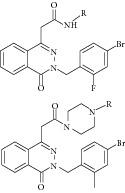
|
Synthetic | — | Mycobacterium tuberculosis | 40.62–66% inhibition at 10 μM |
Positive control 3-nitropropionate has 68.2% inhibition at 100 μM |
|
| |||||||
| 18 | 2010 | Extract of traditional Chinese medicine (I2906) [31]
|
— | Plant | Mycobacterium tuberculosis | 134 μg/mL | Control samples were untreated samples |
|
| |||||||
| 19 | 2010 | 5-Nitro-2-furoic acid hydrazones with furan-2-carbaldehyde [37]
|
Synthetic | — | Mycobacterium tuberculosis | 86.8% inhibition at 10 mM |
Positive control 3-nitropropionate has 63.2% inhibition at 100 μM (good inhibitory) |
|
| |||||||
| 20 | 2010 | Bromophenols [63]
|
Synthetic | — | Candida albicans | 2.65 μM | Positive control IC50 of 3-nitropropionate = 50.7 μM (high inhibitory) |
|
| |||||||
| 21 | 2010 | 5-Nitro-2,6-dioxohexahydro-4-pyrimidinecarboxamides [38]
|
Synthetic | — | Mycobacterium tuberculosis | 45.7% inhibition at 10 mM |
Positive control 3-nitropropionate has 68.2% inhibition at 100 μM (good inhibitory) |
|
| |||||||
| 22 | 2010 | Indole-containing natural compound (analog) [64]
|
Synthetic | — | Candida albicans | 75 μM | Positive control IC50 of 3-nitropropionate = 50 μM (high inhibitory) |
|
| |||||||
| 23 | 2010 | Isatinyl thiosemicarbazones derivatives [39]
|
Synthetic | — | Mycobacterium tuberculosis | 63.44% inhibition at 10 mM |
Positive control 3-nitropropionate has 65.9% inhibition at 100 mM (good inhibitory) |
|
| |||||||
| 24 | 2011 | Brominated resorcinol dimer [65] 
|
Synthetic | — | Candida albicans | 28 μM | Positive control IC50 of 3-nitropropionate = 6.0 μM (good inhibitory) |
|
| |||||||
| 25 | 2011 | Sargachromanols [53]
|
Sargassum siliquastrum | Brown algae | Candida albicans | 118.4–172.9 μM | Positive control IC50 of 3-nitropropionate = 34.8 μM (moderate inhibitory) |
|
| |||||||
| 26 | 2011 | Scalarane sesterterpenes [54]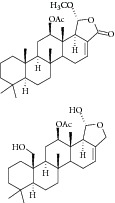
|
Hyatella sp. | Marine sponge | Candida albicans | 40.8–55.3 μM | Positive control IC50 of 3-nitropropionate = 27.9 μM (weak inhibitory) |
|
| |||||||
| 27 | 2011 | Suvanine salt [55] 
|
Coscinoderma sp. | Marine sponge | Candida albicans | 5–17 μM | Positive control IC50
of 3-nitropropionate = 27.9 μM (moderate inhibitory) |
|
| |||||||
| 28 | 2011 | Chelerythrine extract [32] | Chelidonium majus | Plant | Mycobacterium tuberculosis | Expression level decreased 5 fold | — |
|
| |||||||
| 29 | 2011 | Mannich base, Ydcm67 [42]
|
Synthetic | — | Mycobacterium tuberculosis | 57.4% inhibition at 0.05 mg/mL | Positive control oxalic acid has 95.55% inhibition at 0.05 M |
|
| |||||||
| 30 | 2011 | Peptide inhibitor [43] | Synthetic | — | Mycobacterium tuberculosis | Inhibition rate 38.2–47.92% |
Samples contain no peptide inhibitor or ICL in reaction system as controls |
|
| |||||||
| 31 | 2011 | 3-Nitropropionamides derivatives [40]
|
Synthetic | — | Mycobacterium tuberculosis | 0.1 μM | Positive control IC50 of 3-nitropropionate = 116.0 μM (good inhibitory) |
|
| |||||||
| 32 | 2012 | Pyruvate-isoniazid analog with their copper complex [45]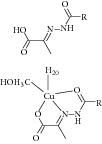
|
Synthetic | — | Mycobacterium tuberculosis | Inhibition rate 6–92% |
Control docking using pyruvic acid |
|
| |||||||
| 33 | 2012 | Bahamaolides A (macrolide) [56]
|
Streptomyces sp. | Actinomycete (Actinobacteria) | Candida albicans | 10.8 μM | Positive control IC50 of 3-nitropropionate = 20.1 μM (high inhibitory) |
|
| |||||||
| 34 | 2012 | Beta-carboline alkaloid [57]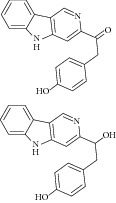
|
Synoicum sp. | Ascidian (sea squirt) |
Candida albicans | 48.2–68.9 μM | Positive control IC50 of 3-nitropropionate = 38.6 μM (weak inhibitory) |
|
| |||||||
| 35 | 2012 | Sphingolipid [58]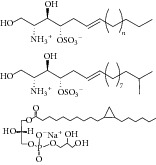
|
Spirastrella abata | Marine sponge | Candida albicans | 2–87 μM | Positive control IC50 of 3-nitropropionate = 1.0 μM (weak to moderate inhibitory) |
|
| |||||||
| 36 | 2012 | Thio benzanilide [66]
|
Synthetic | — | Mycobacterium tuberculosis | 21–23% inhibition at 10 μmol/L | Positive control 3-nitropropionate has 25% inhibition at 10–100 μmol/L |
|
| |||||||
| 38 | 2012 | Salicylanilide derivatives [67]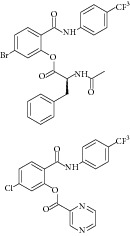
|
Synthetic | — | Mycobacterium tuberculosis | 22–59% inhibition at 10–100 μmol/L | Positive control 3-nitropropionate has 25–67% inhibition at 10–100 μmol/L |
|
| |||||||
| 39 | 2013 | Tris-aromatic furanones [59]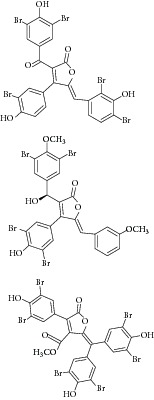
|
Synoicum sp. | Ascidian (sea squirt) |
Candida albicans | 7.62–10.36 μM | Positive control IC50
of 3-nitropropionate = 13.91 μM (Good inhibitory) |
|
| |||||||
| 40 | 2013 | Heptapeptide [44] | Synthetic | — | Mycobacterium tuberculosis | 126 μM | Positive control IC50 of 3-nitropropionate = 50.7 μM (good inhibitory) |
*Inhibition default unit is IC50 unless other units are mentioned in the table.
*Inhibitory potential of potential inhibitors was evaluated by the respective authors.
